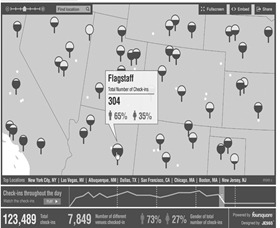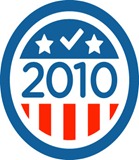 While most of the news surrounding Foursquare’s announcement on Mashable that users will now get a custom badge for voting on election day, so far not much has been written about the most interesting, and potentially explosive aspect- the Foursquare election data visualization site.
While most of the news surrounding Foursquare’s announcement on Mashable that users will now get a custom badge for voting on election day, so far not much has been written about the most interesting, and potentially explosive aspect- the Foursquare election data visualization site.
Although Gowalla was first to announce an election badge and actively seek to partner with individual campaigns, Foursquare along with partner organizations have taken it to the next level with their integration of OpenStreetMap and official polling locations provided by the Voting Information Project.
Traditionally campaigns have monitored turnout on election day by recording the cumulative total of votes cast per polling place on an hourly basis. This data is then put into a spreadsheet / giant whiteboard and if turnout is lower than expected, you redirect all of your phone banks and canvassers to ‘flush’ your voters out of their homes and to the polls.
In 2008 the Obama campaign realized that rather than wait an hour, they could get real time results that would not only tell them how many people voted, but also who voted. Thanks to smart phones, a simple web application and local election laws allowing campaign volunteers to be inside polling places, the Obama campaign now had real time results of how well they were doing. (Disclosure: I volunteered for the Obama campaign as a legal poll monitor and observed this first hand. I do not know if McCain campaign had a similar program.)
If voters do embrace Foursquare to check into polling places for the 2010 midterms, not only could this boost turnout for key demographics and identify issues at polling places, it could also make exit polling obsolete.
 With this new data on hand, a savvy campaign or organization could create another app to search for the #ivoted hashtag and report back a list of users who checked into certain precincts. Next, an algorithm performs a quick sentiment analysis of past tweets to determine political affiliation, and BINGO- up to the minute election results. While no automated sentiment analysis is perfect, I would imagine that counting & comparing the number of politicians someone follows would get you close. Cross checking with the candidates followers would get you closer still. Count the # of @BarackObama vs. @SarahPalinUSA re-tweets and you’re there.
With this new data on hand, a savvy campaign or organization could create another app to search for the #ivoted hashtag and report back a list of users who checked into certain precincts. Next, an algorithm performs a quick sentiment analysis of past tweets to determine political affiliation, and BINGO- up to the minute election results. While no automated sentiment analysis is perfect, I would imagine that counting & comparing the number of politicians someone follows would get you close. Cross checking with the candidates followers would get you closer still. Count the # of @BarackObama vs. @SarahPalinUSA re-tweets and you’re there.
So What Should Campaigns Do?
Besides email address and cell phone numbers- Ask for Twitter handles. Encourage your supporters to sign up for Twitter and Foursquare to support your candidate and let you know when they have voted. If you have a Foursquare account for your candidate, you would also have the benefit of a customized stream of your supporters checking in and voting.
What Will Campaigns Do?
As my former colleague Philip de Vellis of Murphy Putnam pointed out at the Politico / Facebook panel on politics and social media Monday evening, in times of uncertainty campaigns tend to fall back on what they know- namely TV ads. Others mentioned that campaigns have shifted to spending less than 5% of their budgets online. Given that devoting resources to something new and unproven is a little bit scary, I predict that widespead adoption of social media advertising (and spending that follows) will not be broadly adopted until 2012.
For some background on how this all came about, check out the 9/28 RWW blog posting “Could Location Base Services Increase Civic Engagement in Millennials.”
Sign up today to have our latest posts delivered straight to your inbox.